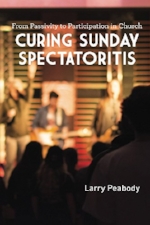Antenna or Cable?
TV antenna versus cable connection: how can the difference illustrate an important truth about shared church? Stay tuned.
But First, Three Questions About Shared Church:
- What is it?
- When was it impossible?
- How is it possible today?
What Is Shared Church?
When I got out of bed this morning, my body reminded me how shared church works. Eyes saw the numbers on the clock. Brain interpreted those numbers as time to roll out of bed. Legs and arms went into action to move me from mattress to floor. Feet carried me to the kitchen. Fingers pushed buttons to start the coffee-maker. Heart, lungs, nerves, etc., all chipped into the getting-up project as well.
Each part of my body shared in the work of getting my day underway. The New Testament says the church is a body. Its various parts—each one uniquely made to contribute—are to work together to carry out the chores that belong to the whole body. Arms and legs, if unable to move, severely curb what a physical body can do. In a church body, some ways of gathering together can immobilize members, so that only a few carry on the work. Such paralysis turns the church into an audience.
But we are “members together of one body, and sharers together in the promise of Christ Jesus” (Eph. 3:6). In shared church, we don’t just spectate. We participate.
When Was Shared Church Impossible?
Back before Jesus came and did his work on earth, the Jews met together in various ways. But in most Old Testament assemblies, the Israelites met as audiences. Moses and Joshua “told the people” (Num. 11:24; Josh. 3:5). God spoke to his people through priests, Levites, and prophets. Ezra the scribe “stood on a high wooden platform” and read the law to the people (Neh. 8:4-13).
Although God had intended for his chosen people to serve him as “a kingdom of priests” (Ex. 19:6), they shank back from coming near to God themselves. At the giving of the Ten Commandments, “When the people saw the thunder and lightning and heard the trumpet and saw the mountain in smoke, they trembled with fear. They stayed at a distance and said to Moses, ‘Speak to us yourself and we will listen. But do not have God speak to us or we will die’” (Ex. 20:18-19).
So at the foot of Mt. Sinai, the stage was set for a largely one-way, monovoiced, meeting format in ancient Israel. Shared church was impossible under the Old Covenant, in part because the people insisted that someone else listen to what God said and then pass it along to them.
How Is Shared Church Possible Today?
But things took a sharp turn under the New Covenant. Jesus, by his death and resurrection, won our forgiveness and gave us access to God’s throne. Upon his return to the right hand of his Father, God fulfilled a promise made hundreds of years earlier by Joel, the prophet: “I will pour out my Spirit on all people. Your sons and daughters will prophesy, your old men will dream dreams, your young men will see visions. Even on my servants, both men and women, I will pour out my Spirit in those days” (Joel 2:28-29).
The presence of the Holy Spirit in all Christ-followers—and his gifts to us—make shared church possible today. He is not only “with” but “in” us. He provides gifts of knowledge, gifts of speaking, gifts of serving others. He teaches us, counsels us, guides us. Unlike God’s people in Old Covenant days, we don’t have to rely exclusively on a few religious professionals who tune in to God and tell us what he says. Being gifted by and filled with the Holy Spirit is the birthright of everyone who trusts Jesus.
Yes, in some, the Holy Spirit’s gifts make them able to help fellow Christians discover and develop their gifts. Church leaders are to serve as coaches, activators, trainers of apprentices, so that God’s people become doers—not merely hearers—of his Word. As a result, “the whole body [church] . . . grows and builds itself up in love, as each part does its work” (Eph. 4:16).
In this way, under the New Covenant, shared church is possible today. But it’s still too easy to revert to Old Covenant-style meetings that rely on religious professionals doing most of the work.
From Antenna to Cable
I’m old enough to remember climbing onto the roof to install a TV antenna and fiddling with a set of “rabbit ears” on top of the television set to get the best signal. When I was young, we had access to just one channel that brought us a fuzzy, black-and-white picture. Today, we have access not only to countless TV channels but also to the Internet—no longer through clumsy antennas but through coaxial cables.
In some ways, the bygone days of rabbit ears and rooftop “antlers” are like meetings under the obsolete Old Covenant. Pretty much one-way communication. We and our television sets were mere receivers. A few professionals—news reporters, actors, musicians—prepared the programs for us, which we passively consumed. Of course, even with cable TV we can still veg out as couch potatoes.
But cable has opened opportunities that resemble the kinds of church meetings now possible through the Holy Spirit under the New Covenant. In the cable era, terms like smart TV and interactive television have entered our vocabulary. Cable allows me to teach theology-of-work classes via the Internet. The students and I can share in back-and-forth interaction not only in writing but also via Zoom. In an online “Zoom Room,” we can see each other’s faces and hear each other’s voices by means of our computer cameras, microphones, and speakers.
“When you meet together, one will sing, another will teach, another will tell some special revelation God has given, one will speak in tongues, and another will interpret what is said. But everything that is done must strengthen all of you” (I Cor. 14:26, NLT). Antennas work only as intakers. Cables permit give-and-take. Church meetings patterned on Old Covenant gatherings are largely one-way events. But meeting formats like those found in the New Testament allow both giving and receiving. The explosive growth of the early church took place in just that kind of a context.






































